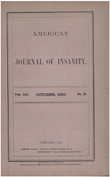Suicidality among patients with mixed and manic bipolar disorder
Abstract
OBJECTIVE: Patients with mixed or manic bipolar disorder were studied to determine whether suicidality in mania is associated with increasing depression in general (i.e., a dimensional construct based on symptom severity) or with the presence of a mixed state per se (i.e., a categorical construct requiring the presence of a full depressive syndrome). METHOD: Diagnostic (categorical) assessments of 91 consecutively hospitalized patients with DSM-III-R mixed or manic bipolar disorder were made by using the Structural Clinical Interview for DSM-III-R. Symptom (dimensional) assessments were made by using the Hamilton Depression Rating Scale, the Young Mania Rating Scale, and the Scale of the Assessment of Positive Symptoms. Logistic regression models were employed to test the relative associations between suicidality and dimensional and categorical depression measures. Receiver operating characteristics analysis was performed to identify a potential threshold depression rating that predicted suicidality. RESULTS: Suicidality was more common in mixed than manic bipolar disorder. However, when adjusted for total depression scores, this association with affective state did not persist, but the statistical model significantly improved. In the improved model, depressive symptom ratings were significantly associated with suicidality. Hamilton depression scale ratings greater than 18 identified over 90% of the patients with suicidality, although there was also a high rate of false positives (32%). CONCLUSIONS: It is the severity of concurrent depressive symptoms in mania, rather than the presence of a depressive syndrome per se (i.e., mixed state), that is associated with suicidality in bipolar patients.
Access content
To read the fulltext, please use one of the options below to sign in or purchase access.- Personal login
- Institutional Login
- Sign in via OpenAthens
- Register for access
-
Please login/register if you wish to pair your device and check access availability.
Not a subscriber?
PsychiatryOnline subscription options offer access to the DSM-5 library, books, journals, CME, and patient resources. This all-in-one virtual library provides psychiatrists and mental health professionals with key resources for diagnosis, treatment, research, and professional development.
Need more help? PsychiatryOnline Customer Service may be reached by emailing [email protected] or by calling 800-368-5777 (in the U.S.) or 703-907-7322 (outside the U.S.).



